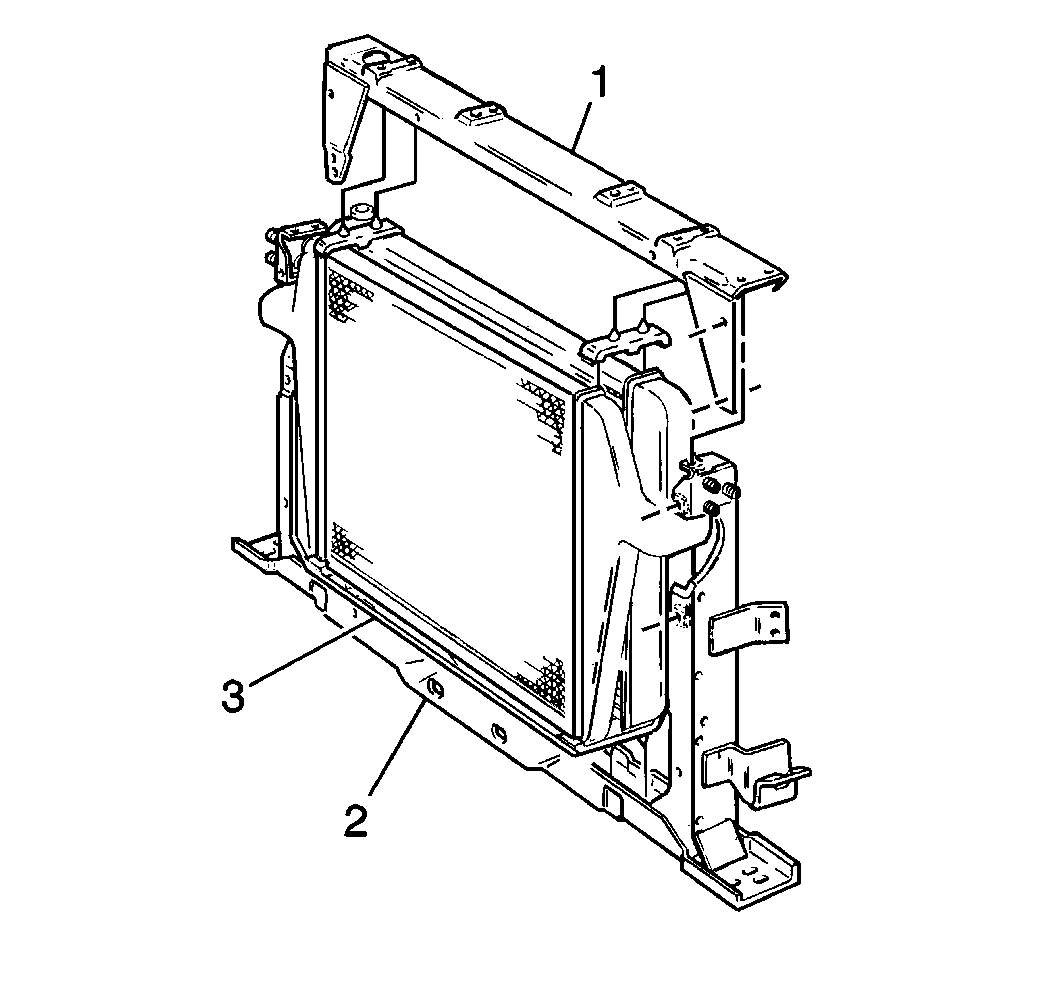Removal Procedure
Important: Always install a new set of insulators when replacing a radiator. Used insulators may be worn or too large for the new radiator. These conditions may cause the new radiator to be loose.
Some assemblies are equipped with an engine oil cooler and/or an automatic transmission oil cooler in the side tanks. Before you remove the oil cooler lines, provide a container to catch the oil that is drained from the cooler and the lines. Do not reuse the drained fluid.
- Remove the front wheelhouse panel. Refer to Wheelhouse Panel Replacement in Body Front End.
- Remove the front intake air duct (1) from the air filter housing.
- Drain the coolant. Refer to Cooling System Draining and Filling .
- Remove the upper radiator hose. Refer to Radiator Inlet Hose Replacement .
- Remove the coolant recovery hoses or the surge tank hose(s) from the radiator.
- Remove the surge tank mount, if equipped. Refer to Radiator Surge Tank Replacement .
- Remove the automatic transmission cooler lines, if equipped.
- Remove the engine oil cooler lines and the quick connector fittings, if equipped. Refer to Engine Oil Cooler Hose/Pipe Replacement .
- Remove the lower radiator hose. Refer to Radiator Outlet Hose Replacement .
- Remove the heater hose.
- Remove the fan shroud bolts. Position the fan shroud rearward.
- Remove the upper air conditioning condenser mounting bolts, if equipped.
- Remove the radiator upper mounting panel bolts.
- Remove the radiator upper mounting panel (1).
- Remove the radiator (3) from the lower mounting panel (2).
- Remove the radiator insulators.
- Inspect the following components:


| • | The radiator |
| • | The hoses |
| • | The mounting hardware |
| • | Replace the components as necessary. |
Installation Procedure
- Install the radiator insulators.
- Install the radiator (3) into the lower mounting panel (2).
- Install the radiator upper mounting panel (1).
- Install the radiator upper mounting panel bolts.
- Install the upper air conditioning condenser mounting bolts, if equipped.
- Install the fan shroud.
- Install the engine oil cooler lines and the quick connector fittings, if equipped.
- Install the automatic transmission oil cooler lines, if equipped.
- Install the lower radiator hose. Refer to Radiator Outlet Hose Replacement .
- Install the heater hose.
- Connect the coolant recovery hose(s) or the surge tank hose(s) to the radiator. Refer to the following procedures:
- Install the upper radiator hose. Refer to Radiator Inlet Hose Replacement .
- Install the front wheelhouse panel. Refer to Wheelhouse Panel Replacement in Body Front End.
- Connect the front intake air duct (1) to the air filter housing.
- Fill the cooling system. Refer to Cooling System Draining and Filling .
- Fill the automatic transmission to the proper capacity, if equipped. Refer to Approximate Fluid Capacities in Automatic Transmission.
- Inspect the system for leaks.

Notice: Use the correct fastener in the correct location. Replacement fasteners must be the correct part number for that application. Fasteners requiring replacement or fasteners requiring the use of thread locking compound or sealant are identified in the service procedure. Do not use paints, lubricants, or corrosion inhibitors on fasteners or fastener joint surfaces unless specified. These coatings affect fastener torque and joint clamping force and may damage the fastener. Use the correct tightening sequence and specifications when installing fasteners in order to avoid damage to parts and systems.
Tighten
Tighten the upper mounting panel bolt to 25 N·m (18 lb ft).
Tighten
Tighten the air conditioning condenser mounting bolt to 25 N·m
(18 lb ft).
Tighten
Tighten the fan shroud bolts to 6 N·m (53 lb in).
Tighten
| • | Tighten the engine oil cooler hose fitting to radiator to 60 N·m (44 lb ft). |
| • | Tighten the engine oil cooler quick connector-to-hose fitting to 35 N·m (26 lb ft). |
Tighten
Tighten the transmission cooler line fitting to 30 N·m
(22 lb ft).

